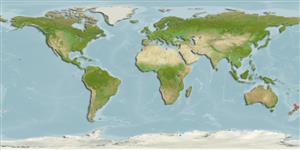>
Blenniiformes (Blennies) >
Tripterygiidae (Triplefin blennies) > Tripterygiinae
Etymology: Notoclinops: Greek, noton = back + Greek, klinein, kline = sloping and also bed, due to the four apophyses of sphenoid bone + Greek, ops = appearance (Ref. 45335).
Environment: milieu / climate zone / depth range / distribution range
นิเวศวิทยา
เกี่ยวกับทะเล,น้ำเค็ม สัตว์น้ำหน้าดิน; ระดับความลึก 0 - 40 m (Ref. 9003). Temperate
Southwest Pacific: New Zealand.
ขนาด / น้ำหนัก / Age
Maturity: Lm ? range ? - ? cm
Max length : 3.6 cm SL เพศผู้/กระเทย; (Ref. 13227)
Short description
เครื่องมือที่ใช้ในการแยกชนิดสัตว์,สิ่งมีชีวิตออกจากกัน | สัณฐานวิทยา | ความยาวต่างๆ
เงี่ยงครีบหลัง (รวม) : 21 - 23; ก้านครีบอ่อนที่หาง (รวม) : 10 - 13; เงี่ยงครีบก้น: 1; ก้านครีบอ่อนที่ก้น: 23 - 25. Head mauve with bright orange patches. Eyes with a fine bright blue line around pupils. Body with 9-10 orange to blackish dorsal bands on the posterior half. Distinguished from other triplefins by the distinctive color pattern. Pelvic fins reduced to 2 rays.
Adults occur in tidal pools and the subtidal zone, usually on encrusted walls and other overhangs. They remove parasites from large fishes such as moray eels (Ref. 13227). Eggs are hemispherical and covered with numerous sticky threads that anchor them in the algae on the nesting sites (Ref. 240). Larvae are planktonic which occur primarily in shallow, nearshore waters (Ref. 94114).
Life cycle and mating behavior
Maturities | การสืบพันธุ์ | Spawnings | Egg(s) | Fecundities | ตัวอ่อน
Fricke, R., 1994. Tripterygiid fishes of Australia, New Zealand and the southwest Pacific Ocean (Teleostei). Theses Zool. 24:1-585. (Ref. 13227)
IUCN Red List Status (Ref. 130435)
Threat to humans
Harmless
Human uses
เครื่องมือ
Special reports
Download XML
แหล่งที่มาจากอินเตอร์เน็ต
Estimates based on models
Preferred temperature (Ref.
123201): 13.6 - 22.3, mean 18.2 °C (based on 30 cells).
Phylogenetic diversity index (Ref.
82804): PD
50 = 0.6250 [Uniqueness, from 0.5 = low to 2.0 = high].
Bayesian length-weight: a=0.00562 (0.00258 - 0.01228), b=3.08 (2.89 - 3.27), in cm total length, based on LWR estimates for this (Sub)family-body shape (Ref.
93245).
ระดับชั้นอาหาร (Ref.
69278): 3.1 ±0.3 se; based on size and trophs of closest relatives
ความสามารถในการกลับคืนสู่ปกติ (Ref.
120179): ความสูง, เวลาต่ำสุดที่จะทำให้ประชากรเพิ่มขึ้นเป็น 2 เท่าใช้เวลาน้อยกว่า 15 เดือน (Preliminary K or Fecundity.).
Fishing Vulnerability (Ref.
59153): Low vulnerability (10 of 100).
Nutrients (Ref.
124155): Calcium = 387 [170, 1,915] mg/100g; Iron = 1.47 [0.57, 3.79] mg/100g; Protein = 17.6 [15.8, 19.3] %; Omega3 = 0.459 [0.109, 1.913] g/100g; Selenium = 24.1 [4.7, 100.8] μg/100g; VitaminA = 8.22 [0.95, 66.24] μg/100g; Zinc = 2.61 [1.19, 5.15] mg/100g (wet weight);
